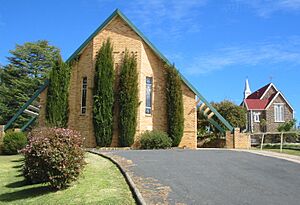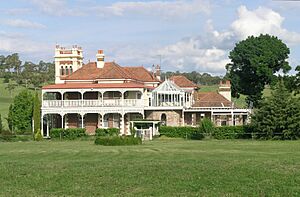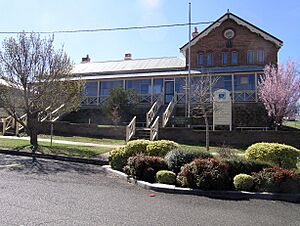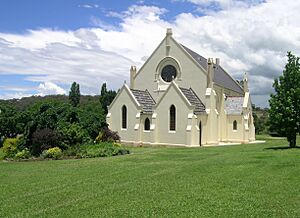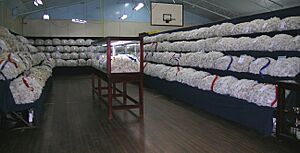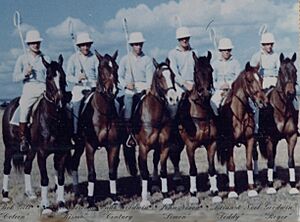Walcha, New South Wales facts for kids
Quick facts for kids WalchaNew South Wales |
|||||||||
|---|---|---|---|---|---|---|---|---|---|
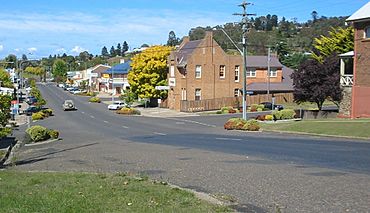
Derby Street, Walcha
|
|||||||||
| Established | 1852 | ||||||||
| Postcode(s) | 2354 | ||||||||
| Elevation | 1,067.0 m (3,501 ft) | ||||||||
| Time zone | AEST (UTC+10) | ||||||||
| • Summer (DST) | AEDT (UTC+11) | ||||||||
| Location |
|
||||||||
| LGA(s) | Walcha Shire | ||||||||
| Region | Northern Tablelands | ||||||||
| County | Vernon | ||||||||
| Parish | Walcha | ||||||||
| State electorate(s) | Tamworth | ||||||||
| Federal Division(s) | New England | ||||||||
|
|||||||||
Walcha is a town in the Northern Tablelands region of Australia. It is located in the state of New South Wales. Walcha is the main town for the Walcha Shire area.
The town is about 425 kilometers (264 miles) by road from Sydney. It sits where the Oxley Highway and Thunderbolts Way meet. The Apsley River flows through Walcha. This river then forms the amazing Apsley Falls before joining the Macleay River. In the past, the river caused floods in the town. A special wall, called a levee bank, was built to stop these floods. In 2021, Walcha had 1,369 people living there.
The Main North railway line is 20.7 kilometers (12.9 miles) west of Walcha. It is at a village called Walcha Road. This is where people can catch the train. The railway was built there because it was too hard to build it closer to Walcha. This was due to the steep mountains of the Great Dividing Range.
Contents
Discovering Walcha's Past
Early Aboriginal History
The land around Walcha was home to the Dhanggati (or Dunghutti) People for 6,000 years. They used the tablelands for special ceremonies and trading goods. You can still find traces of their ancient meeting places, called bora grounds, near Walcha. During colder times, the tribes would move to the warmer gorge country to the east. There, they found plenty of fish and animals.
European Settlement and Growth
In 1818, John Oxley was the first European to explore this area. He also found the beautiful waterfalls, which were later named Apsley Falls.
The first European settler in the New England area was Hamilton Collins Sempill. He started a farm called 'Wolka' in 1832. Other early farms, called runs, were set up around the district. These included Bergen-op-Zoom (1834) and Ohio (1836). A tough time from 1841 to 1843, with low demand for wool, made life hard for many early settlers.
The Walcha Post Office opened on July 1, 1850. Mail came from Macdonald River, which is now Bendemeer. Walcha was officially made a village in 1852. That's when land was first sold for building homes and shops. At that time, Walcha had a blacksmith, a general store, and a flour mill. A Catholic church was built in 1854. A police station and the first Presbyterian church were built in 1857. Walcha Central School opened in 1859.
In 1861, Walcha had 355 people. The Anglican church was built in 1862. It was made from stone from an old house called 'Villa Walcha'. This church has beautiful stained-glass windows. They honor some of the first people who settled in the town.
Mining and Development
The town grew again in the 1870s. This was because people started cutting red cedar trees from the rainforests. Also, gold was found near Walcha in the 1870s. Other valuable minerals like antimony, copper, and silver were also mined.
On April 5, 1878, Walcha was officially declared a town. A courthouse was built. A train line to Sydney and other towns opened at Walcha Road in 1882. Walcha became its own local government area in 1889. The Walcha Pastoral & Agricultural Association started in 1890. This group holds an annual show with amazing displays of livestock, wool, and crafts. The Walcha Cottage Hospital was founded in 1890.
In 1950, something special happened in Walcha. A Tiger Moth plane was the first aircraft in Australia to spread fertilizer, called superphosphate, from the air. This helped farms grow much more livestock. In 1992, the Walcha Telecottage was set up. It was the first "telecentre" in Australia. It helps the community with job training, online learning, and internet access.
Walcha's Historic Places
Walcha has several places that are important for their history. These are called heritage-listed sites. They include:
- Ohio Homestead
- South Street: St Andrew's Anglican Church
- Thee Street: St Andrew's Rectory
- Main Northern railway: Walcha Road railway station
Many other local buildings and natural sites are also listed as important. These include:
- Apsley Gorge National Park
- Europambela Homestead
- Langford Homestead
- St Paul's Presbyterian Church and Fletcher Memorial Hall
- Walcha Courthouse
Walcha's Climate and Weather
Walcha has a climate that is like an oceanic climate, but it also has some features of a 'continental' climate. This means it has a wide range of temperatures. In July, the temperature can go from -2.0°C (28.4°F) to 11.9°C (53.4°F). In February, it can range from 12.1°C (53.8°F) to 25.2°C (77.4°F).
The average rainfall each year is 808.6 mm (31.8 inches). It often snows and freezes in winter. The highest temperature ever recorded in Walcha was 35.6°C (96.1°F). The lowest was -12.8°C (9.0°F).
| Climate data for Walcha Post Office (1957–1975, rainfall 1879–1996); 1,050 m AMSL; 30.99° S, 151.59° E | |||||||||||||
|---|---|---|---|---|---|---|---|---|---|---|---|---|---|
| Month | Jan | Feb | Mar | Apr | May | Jun | Jul | Aug | Sep | Oct | Nov | Dec | Year |
| Record high °C (°F) | 35.4 (95.7) |
33.9 (93.0) |
32.2 (90.0) |
28.9 (84.0) |
22.5 (72.5) |
18.9 (66.0) |
19.0 (66.2) |
21.7 (71.1) |
27.2 (81.0) |
30.0 (86.0) |
34.2 (93.6) |
35.6 (96.1) |
35.6 (96.1) |
| Mean daily maximum °C (°F) | 25.3 (77.5) |
25.2 (77.4) |
23.1 (73.6) |
20.3 (68.5) |
15.5 (59.9) |
12.7 (54.9) |
11.9 (53.4) |
12.7 (54.9) |
16.2 (61.2) |
19.9 (67.8) |
22.5 (72.5) |
24.7 (76.5) |
19.2 (66.5) |
| Mean daily minimum °C (°F) | 11.6 (52.9) |
12.1 (53.8) |
9.7 (49.5) |
5.5 (41.9) |
1.3 (34.3) |
0.0 (32.0) |
−2.0 (28.4) |
−0.2 (31.6) |
1.8 (35.2) |
5.6 (42.1) |
7.8 (46.0) |
10.4 (50.7) |
5.3 (41.5) |
| Record low °C (°F) | 1.0 (33.8) |
2.2 (36.0) |
−2.8 (27.0) |
−5.6 (21.9) |
−10.6 (12.9) |
−11.7 (10.9) |
−12.8 (9.0) |
−10.0 (14.0) |
−7.2 (19.0) |
−4.2 (24.4) |
−2.2 (28.0) |
−1.0 (30.2) |
−12.8 (9.0) |
| Average rainfall mm (inches) | 103.9 (4.09) |
86.3 (3.40) |
63.1 (2.48) |
44.8 (1.76) |
46.2 (1.82) |
58.6 (2.31) |
54.4 (2.14) |
53.4 (2.10) |
56.1 (2.21) |
70.7 (2.78) |
80.8 (3.18) |
90.0 (3.54) |
808.6 (31.83) |
| Average rainy days (≥ 0.2mm) | 8.7 | 7.8 | 7.4 | 6.3 | 7.1 | 8.8 | 8.3 | 8.1 | 7.4 | 8.5 | 8.4 | 8.6 | 95.4 |
| Source: Bureau of Meteorology | |||||||||||||
Plants and Animals of Walcha
Local Flora: Walcha's Native Plants
The Walcha area has many different types of plants. You can see them growing naturally in the town and nearby. Some common native plants include:
- acacias (wattles)
- Eucalyptus melliodora (yellow box)
- Eucalyptus nicholii (Narrow-leaved Black Peppermint)
- Exocarpos cupressiformis (native cherry)
Some rare or endangered plants also grow in the district's national parks. These include:
- Chiloglottis anaticeps (bird orchid)
- Eucalyptus michaeliana (Hillgrove spotted gum)
Local Fauna: Walcha's Wildlife
You might see many animals in and around Walcha. These include:
- Grey kangaroos
- Wallabies
- Possums
- echidnas (spiny ant eaters)
- Black and brown snakes
- Eastern Blue-tongued Lizards
- Amphibolurus muricatus (Jacky dragons)
Many birds also live in the area, such as:
Walcha's Economy and Industries
Walcha is known as the "Pasture Wonderland." This is because farming livestock is the main industry here. The area has about 937,000 sheep, mostly Merinos. It also has around 85,500 beef cattle. The wool from Walcha is considered some of the best in the world. There is also a growing timber industry. A large modern dairy farm near the town produces about seven million liters of milk each year.
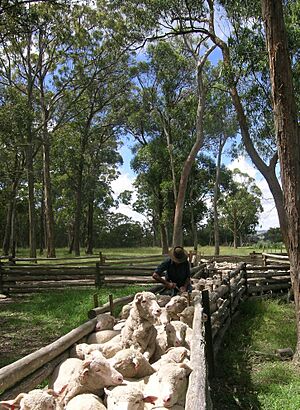
Some famous Thoroughbred racehorses have come from this area. These include Blue Spec, who won the Melbourne Cup, and Kennaquhair, who won the Sydney Cup. There is a Thoroughbred horse farm near the town.
Walcha also has several large trucking companies and an engineering business. All the usual shops and services you need can be found in the town.
Fun Things to See and Do in Walcha
Natural Wonders and Parks
Walcha has many beautiful natural attractions. The Apsley Falls are about 20 kilometers (12 miles) east of town. The first part of the falls drops about 85 meters (279 feet). The second part drops around 65 meters (213 feet). Walcha is the southern entrance to the Oxley Wild Rivers National Park and Werrikimbe National Park. These parks are part of the Gondwana Rainforests of Australia, which are a World Heritage site. Other nearby national parks include Mummel Gulf National Park and Cottan-Bimbang National Park.
Art and Culture
Walcha has a special Open Air Gallery. Local and international artists have created about 41 sculptures and artworks around the town. There are also 30 carved verandah posts in front of local shops. This makes Walcha a very artistic community for its size. The town also has a large collection of art in its local gallery.
Local Attractions and Events
Walcha has four churches: Roman Catholic, Anglican, and Presbyterian. There are many other fun things to do for visitors. You can go on scenic 4WD trips, hiking, or visit the State Forests. Fishing and looking for minerals (fossicking) are also popular. You can also visit the Amaroo Museum & Cultural Centre and the Pioneer Cottage museum.
Walcha hosts several big annual events. These include the Walcha Jockey Club races, the Walcha Bushmen's Campdraft and Rodeo, and the Walcha Show. The Bushmen's Campdraft and Rodeo group gives a lot of money to local charities each year. The New England Merino Field Days happen every two years. They show off local sheep, wool, and farms. There is also a Timber Expo and a Garden Festival every two years.
Famous People from Walcha
- Edward Baker-Boulton (1812-1895) was the grandfather of the famous English children's author, Arthur Ransome. Ransome wrote the popular Swallows and Amazons books.
- Bob Beer is known for his amazing endurance feats. He rode a bike around Australia when he was 58. He was also the first person to run across the 420 km (261 miles) Simpson Desert.
- Peter Fenwicke, a rugby union player, was captain of the Australian team on its first world tour in 1957-58.
- The Goodwin brothers – Paul, Maurice, Noel, and Brian – along with Bob Gill and John Nixon, were part of a very successful Walcha polocrosse team. They won the Australian championships in 1962.
- Stephen King is an internationally recognized sculptor.
- Andrew Laurie was an Australia national rugby union team ("Wallaby") player.
- Angus Nivison won the Art Gallery of NSW’s Wynne Prize for landscape in 2002.
- Sam Payne was a former Australia national rugby union team ("Wallaby") halfback.
- Mrs Esther Stace set an unbroken world record in sidesaddle show jumping. She jumped 6 feet 6 inches (1.98 meters).
- Knight's Choice, the horse that won the 2024 Melbourne Cup, was born in Walcha. This made it the second Walcha-born horse to win the Melbourne Cup.
Several Walcha residents have received the Medal of the Order of Australia (OAM) for their service to the community. These include:
- Adrian Mark Allen, for service to medicine and the community.
- Ruth Louise Cotterill, for service to the community.
- Andrew John Cross, for service to the community.
- Shirley Norma Davison, for service to the Walcha region, especially through the Amaroo Local Aboriginal Land Council.
Images for kids



